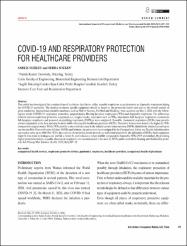| dc.contributor.author | Sözkes, Sarkis | |
| dc.contributor.author | Sözkeş, S. | |
| dc.date.accessioned | 2023-05-06T17:19:37Z | |
| dc.date.available | 2023-05-06T17:19:37Z | |
| dc.date.issued | 2021 | |
| dc.identifier.issn | 1232-1087 | |
| dc.identifier.uri | https://doi.org/10.13075/IJOMEH.1896.01666 | |
| dc.identifier.uri | https://hdl.handle.net/20.500.11776/11892 | |
| dc.description.abstract | This article has investigated the considerations of healthcare facilities to utilize reusable respirators as an alternative to disposable respirators during the COVID-19 pandemic. The decision to choose specific equipment should be based on the protection factors and also on the overall analysis of given conditions. International scientific databases, such as Web of Science, PubMed and MedLine, were searched on May 5, 2020, with the following key words: COVID-19, respiratory protection, surgical masks, filtering facepiece respirators (FFRs) and disposable respirators. The differences between various respiratory protective equipment, i.e., surgical masks, respirators such as FFRs, elastomeric half-facepiece respirators, elastomeric full-facepiece respirators and powered air-purifying respirators (PAPRs), were compared. Reusable elastomeric respirators (RERs) may provide a better adaptation to the face and may be more stable when used by healthcare providers (HCPs). Protection factors were found to be higher in FFRs compared to surgical masks. While FFRs provide a one-tenth decrease in the inhaled aerosol concentration, PAPRs diminish the inhaled aerosol up to one-twenty-fifth. Even with some full-face PAPRs and helmets, the protection factor assigned by the Occupational Safety and Health Administration can reach a value up to 1000. For HCPs, the evidence shown in this article provides an additional support for the utilization of RERs. Such equipment might be less prone to leakages, can provide a better fit, and indicates a better stability compared to disposable FFRs (N95 and similar). By providing higher protection factors, reusable elastomeric respirators are recommended to be used by HCPs under controlled cleaning and disinfection protocols. © 2021 Nofer Institute of Occupational Medicine. All rights reserved. | en_US |
| dc.language.iso | eng | en_US |
| dc.publisher | Nofer Institute of Occupational Medicine | en_US |
| dc.identifier.doi | 10.13075/IJOMEH.1896.01666 | |
| dc.rights | info:eu-repo/semantics/openAccess | en_US |
| dc.subject | Healthcare providers | en_US |
| dc.subject | Occupational health of physicians | en_US |
| dc.subject | Occupational health services | en_US |
| dc.subject | Pandemics | en_US |
| dc.subject | Respirators | en_US |
| dc.subject | Respiratory protective devices | en_US |
| dc.subject | adverse event | en_US |
| dc.subject | aerosol | en_US |
| dc.subject | disease transmission | en_US |
| dc.subject | epidemiology | en_US |
| dc.subject | gas mask | en_US |
| dc.subject | health care personnel | en_US |
| dc.subject | human | en_US |
| dc.subject | occupational exposure | en_US |
| dc.subject | pandemic | en_US |
| dc.subject | prevention and control | en_US |
| dc.subject | Aerosols | en_US |
| dc.subject | COVID-19 | en_US |
| dc.subject | Disease Transmission, Infectious | en_US |
| dc.subject | Health Personnel | en_US |
| dc.subject | Humans | en_US |
| dc.subject | Occupational Exposure | en_US |
| dc.subject | Pandemics | en_US |
| dc.subject | Respiratory Protective Devices | en_US |
| dc.subject | SARS-CoV-2 | en_US |
| dc.title | COVID-19 and respiratory protection for healthcare providers | en_US |
| dc.type | review | en_US |
| dc.relation.ispartof | International Journal of Occupational Medicine and Environmental Health | en_US |
| dc.department | Fakülteler, Çorlu Mühendislik Fakültesi, Biyomedikal Mühendisliği Bölümü | en_US |
| dc.identifier.volume | 34 | en_US |
| dc.identifier.issue | 2 | en_US |
| dc.identifier.startpage | 307 | en_US |
| dc.identifier.endpage | 318 | en_US |
| dc.institutionauthor | Sözkes, Sarkis | |
| dc.relation.publicationcategory | Diğer | en_US |
| dc.authorscopusid | 57224494344 | |
| dc.authorscopusid | 56608188300 | |
| dc.identifier.scopus | 2-s2.0-85104282413 | en_US |
| dc.identifier.pmid | 33231204 | en_US |



















